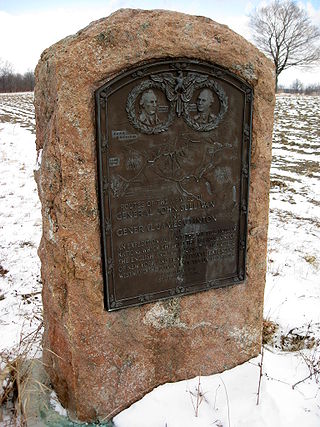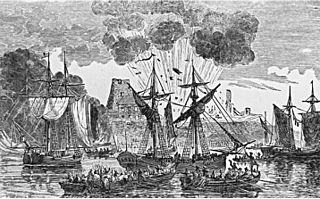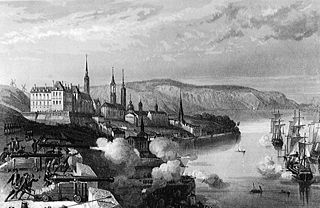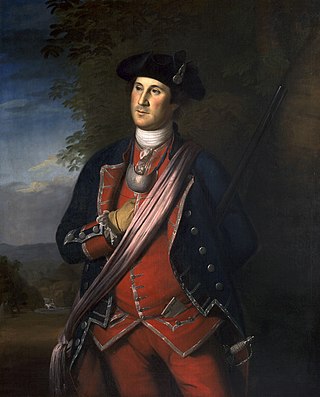
The Battle of Wilton was fought in 1693 in Wilton, New York between Colonial Militia and allied Native forces on one hand and French forces and their Native allies as part of King William's War.

The Battle of Wilton was fought in 1693 in Wilton, New York between Colonial Militia and allied Native forces on one hand and French forces and their Native allies as part of King William's War.
The Battle of Wilton was part of a back-and-forth struggle between the English and French for control of the fur trade in the Province of New York.
In 1687 the Marquis de Denonville, the Governor of New France attacked Seneca in Western New York and burned their towns of Ganondagan and Totiakton. [1]
In retaliation, in 1689, a group of 1500 Mohawks attacked and burned the French town of Lachine on Montreal Island, killing or capturing a substantial number of the inhabitants (the Seneca and Mohawk were both members of the Iroquois confederacy, properly known as the Haudenosaunee).
In 1690 the French, at the command of Count Frontenac launched an attack in the Mohawk Valley which culminated in the burning of Schenectady, New York, killing and capturing a number of inhabitants. [2]
Finally, in 1693, Fontenac decided to attack and weaken the Mohawks of New York, and alienate them from the French-allied Mohawks of Kahnawake, near Montreal. He assembled one hundred soldiers and a number of Canadians and Indians from various tribes. The size of the force has been given as six hundred and twenty-five men. The expedition left Chambly, Quebec at the end of January, travelling on snowshoes. In sixteen days they reached the Mohawk, led by a guide captured in the Schenectady Massacre, Jan Baptiste Van Eps. They captured and burned three large Mohawk towns, called castles, and took a number of captives. The Mohawks had been caught off-guard and the French captured Caughnawaga and Canajoharie without a fight, and Tionondogue after a surprise attack that killed about 20 or 30 and took 300 captives.
Before the expedition left Canada, Frontenac had made his Mohawk allies swear an oath that they would kill all male captives. They "had readily given the pledge, but apparently with no intention to keep it; at least, they now refused to do so," so "the French and their allies began their retreat, encumbered by a long line of prisoners."
Meanwhile, Van Eps had escaped before the attacks and made his way to Schenectady, where he alerted the inhabitants to the French attack. This warning was then passed on to Major Pieter Schuyler, the commander of the Albany County Militia. On February 13 Schuyler crossed the Mohawk on the ice with a force of 237 men and began to pursue the retreating French. On February 15 he was joined by 290 Mohawks who had escaped capture by the French. [3]
The French forces, under the command of Nicholas de Mantet, retreated north up a major trail that stretched from the Quebec to the Mohawk valley. From north to south, this trail "left Lake Champlain at Ticonderoga, came up Lake George to its head, then struck through the forests to the Hudson, crossing the river at the Big Bend west of the present site of Glens Falls. Thence down along the eastern side of the Palmertown Range, past Mt. McGregor to the pass leading west through the range, coming out in Greenfield, passing near Lake Desolation, along the ridge of the Kayaderosseras Range and so across Galway to the Mohawk." [4] On the way Schuyler was joined by a group of Oneidas, bringing his force up to five or six hundred. [3]
The French "marched two days, when they were hailed from a distance by Mohawk scouts, who told them that the English were on their track, but that peace had been declared in Europe and that the pursuers did not mean to fight but to parley. Hereupon, the mission Indians insisted on waiting for them and no exertion of the French commanders could persuade them to move. Trees were hewn down and a fort made, after the Iroquois fashion, by encircling the camp with a high and dense abatis of trunks and branches." [3]
Schuyler caught up to the French encamped in what was then a nearly-uninhabited wilderness, in an area later known as Stiles Corners, in what is now the Town of Wilton. [5] There the north–south trail crossed an east–west trail which ended at the Hudson River at Schuylerville, guarded only by a "blockhouse and a few Dutchmen." The French fort was situated "at the eastern end of the pass through the Palmertown range." [4]
Upon his arrival Schuyler constructed a similar fort to the French, which the French attempted to assault three times without success. Since it was the dead of winter both sides were running low on provisions and approaching starvation. A group of Indians "squatted about a fire, invited Schuyler to share their broth but his appetite was spoiled when he saw a human hand ladled out of the kettle. His hosts were breakfasting on a dead Frenchman."
In the morning, in a blinding snowstorm, scouts observed that the French were packing, preparing to abandon their fort and make their escape. Schuyler was unable to pursue since his men, who had had nothing to eat for three days, refused to follow until they were fed. Finally reinforcements arrived with provisions and the pursuit was continued. When the militia again caught up to the fleeing French the Mohawks refused to fight— the French threatened to kill their prisoners, the wives and children of many of the Mohawks, if they were attacked. "The French, by this time, had reached the Hudson, where, to their dismay, they found the ice breaking up and drifting down the stream. Happily for them, a large sheet of it had become wedged at a turn of the river and formed a temporary bridge, by which they crossed and then pushed on to Lake George." On the trek north they suffered greatly from hunger: "They boiled moccasins for food, and scraped away the snow to find hickory and beech nuts. Several died of famine, and many more, unable to move, lay helpless by the lake; while a few of the strongest toiled on to Montreal." [3]
Schuyler wanted to give chase, but was deterred by the exhaustion and hunger of his troops. Total casualties were four Albany militiamen and four Indians killed and twelve men wounded on one side, and thirty-three French killed including their commander and several officers, and a number wounded on the other. Fifty Mohawk captives were rescued. [3]
Although the battle itself could be considered a victory for the colonists, the overall campaign was definitely a win for the French. The destruction of the Mohawk towns "left the Mohawks absolutely destitute in midwinter." They "sought what shelter was available about their old homes or with their white friends at Schenectady and Albany. They had lost fully one-fifth or more of their tribe, who were now captives of the hated French, and about forty of their warriors had been slain in this invasion. Where they had numbered 270 fighting men at the beginning of King William's war in 1689, they now were only 150 strong." They "were so decimated that the survivors of the Turtle, Bear and Wolf clans now all united and, in the summer of 1693, built a stockaded tribal town, called Og-sa-da-ga, at present Tribes Hill, Montgomery County. From this tribal village of the Mohawks the ancient little town of Tribes Hill derives its name. At Ogsadaga, the Mohawks lived until about the year 1700, when they removed to three new sites on the south side,... located at present Fort Hunter, Fort Plain and Indian Castle." [3]

King William's War was the North American theater of the Nine Years' War (1688–1697), also known as the War of the Grand Alliance or the War of the League of Augsburg. It was the first of six colonial wars fought between New France and New England along with their respective Native allies before France ceded its remaining mainland territories in North America east of the Mississippi River in 1763.

Sir William Johnson, 1st Baronet, was a British Army officer and colonial administrator from Ireland known for his military and governance work in British colonial America.

The Invasion of Quebec was the first major military initiative by the newly formed Continental Army during the American Revolutionary War. The objective of the campaign was to seize the Province of Quebec from Great Britain, and persuade French-speaking Canadiens to join the revolution on the side of the Thirteen Colonies. One expedition left Fort Ticonderoga under Richard Montgomery, besieged and captured Fort St. Johns, and very nearly captured British General Guy Carleton when taking Montreal. The other expedition, under Benedict Arnold, left Cambridge, Massachusetts, and traveled with great difficulty through the wilderness of Maine to Quebec City. The two forces joined there, but they were defeated at the Battle of Quebec in December 1775.

The 1779 Sullivan Expedition was a United States military campaign during the American Revolutionary War, lasting from June to October 1779, against the four British-allied nations of the Iroquois. The campaign was ordered by George Washington in response to the 1778 Iroquois and British attacks on the Wyoming Valley, German Flatts, and Cherry Valley. The campaign had the aim of "taking the war home to the enemy to break their morale." The Continental Army carried out a scorched-earth campaign in the territory of the Iroquois Confederacy in what is now western and central New York.
The Beaver Wars, also known as the Iroquois Wars or the French and Iroquois Wars were a series of conflicts fought intermittently during the 17th century in North America throughout the Saint Lawrence River valley in Canada and the Great Lakes region which pitted the Iroquois against the Hurons, northern Algonquians and their French allies. As a result of this conflict, the Iroquois destroyed several confederacies and tribes through warfare: the Hurons or Wendat, Erie, Neutral, Wenro, Petun, Susquehannock, Mohican and northern Algonquins whom they defeated and dispersed, some fleeing to neighbouring peoples and others assimilated, routed, or killed.

The Battle of Oriskany was a significant engagement of the Saratoga campaign of the American Revolutionary War, and one of the bloodiest battles in the conflict between Patriot forces and those loyal to Great Britain. On August 6, 1777, several hundred of Britain's Indigenous allies, accompanied by Loyalists of the King's Royal Regiment of New York and the British Indian Department, ambushed a Patriot militia column which was marching to relieve the siege of Fort Stanwix. This was one of the few battles in which the majority of the participants were American colonists. Patriots and allied Oneidas fought against Loyalists and allied Iroquois and Mississaugas. No British regulars were involved; however, a detachment of Hessians was present.

Jacques-René de Brisay, Marquis de Denonville was the Governor General of New France from 1685 to 1689 and was an important figure during the intermittent conflict between New France and the Iroquois known as the Beaver Wars.

The Battle of Fort Frontenac took place on August 26–28, 1758 during the Seven Years' War between France and Great Britain. The location of the battle was Fort Frontenac, a French fort and trading post which is located at the site of present-day Kingston, Ontario, at the eastern end of Lake Ontario where it drains into the St. Lawrence River.

Hendrick Theyanoguin, whose name had several spelling variations, was a Mohawk leader and member of the Bear Clan. He resided at Canajoharie or the Upper Mohawk Castle in colonial New York. He was a Speaker for the Mohawk Council. Hendrick formed a close alliance with Sir William Johnson, the Superintendent of Indian affairs in North America.

The Raid on Deerfield, also known as the Deerfield Massacre, occurred during Queen Anne's War on February 29, 1704, when French and Native American raiders under the command of Jean-Baptiste Hertel de Rouville attacked the English colonial settlement of Deerfield, Massachusetts Bay, just before dawn. They burned parts of the town and killed 47 colonists. The raiders left with 112 colonists as captives, whom they took overland the nearly 300 miles to Montreal; some died or were killed along the way because they were unable to keep up. Roughly 60 colonists were later ransomed by their associates, while others were adopted by Mohawk families at Kahnawake and became assimilated into the tribe. In this period, English colonists and their Indian allies were involved in similar raids against French villages along the northern area between the spheres of influence.

Area codes 518 and 838 are telephone area codes in the North American Numbering Plan for eastern Upstate New York in the United States. 518 is one of the 86 original North American area codes created in 1947. Area code 838 was added to the 518 numbering plan area in 2017. The two area codes serve 24 counties and 1,200 ZIP Code areas in a numbering plan area (NPA) that extends from the eastern Mohawk Valley to the Vermont border, and from the Canada–US border to south of Albany. The bulk of the population is in the Capital District, the vicinity of the cities Albany, Schenectady, and Troy. Other cities in the NPA are Glens Falls, Plattsburgh, and Saratoga Springs. It includes the Upper Hudson Valley counties, Greene and Columbia counties, and some northern parts of Dutchess County.

Arent van Curler, later van Corlaer, was the grandnephew of Kiliaen van Rensselaer. In 1637 Rensselaer commissioned him as his secretary and accountant at Rensselaer's patroonship Rensselaerswyck in the Dutch colony of New Netherland.

The Battle of Québec was fought in October 1690 between the colonies of New France and Massachusetts Bay, then ruled by the kingdoms of France and England, respectively. It was the first time Québec's defences were tested.

The Schenectady massacre was an attack against the colonial settlement of Schenectady in the English Province of New York on February 8, 1690. A raiding party of 114 French soldiers and militiamen, accompanied by 96 allied Mohawk and Algonquin warriors, attacked the unguarded community, destroying most of the homes, and killing or capturing most of its inhabitants. Sixty residents were killed, including 11 Black slaves. About 60 residents were spared, including 20 Mohawk.
Pieter "Peter" Schuyler, a member of the Schuyler family, was a wealthy Dutch farmer from New Barbadoes Neck, now western Hudson County, New Jersey. He was a colonel during King George's War and was captured and exchanged as a prisoner during the French and Indian Wars.

The Lachine massacre, part of the Beaver Wars, occurred when 1,500 Mohawk warriors launched a surprise attack against the small settlement of Lachine, New France, at the upper end of Montreal Island, on the morning of 5 August 1689.

The Iroquois, also known as the Five Nations, and later as the Six Nations from 1722 onwards; alternatively referred to by the endonym Haudenosaunee are an Iroquoian-speaking confederacy of Native Americans and First Nations peoples in northeast North America. They were known by the French during the colonial years as the Iroquois League, and later as the Iroquois Confederacy, while the English simply called them the "Five Nations". The peoples of the Iroquois included the Mohawk, Oneida, Onondaga, Cayuga, and Seneca. After 1722, the Iroquoian-speaking Tuscarora people from the southeast were accepted into the confederacy, from which point it was known as the "Six Nations".

Colonial American military history is the military record of the Thirteen Colonies from their founding to the American Revolution in 1775.

The Maliseet militia was made up of warriors from the Maliseet of northeastern North America. Along with the Wabanaki Confederacy, the French and Acadian militia, the Maliseet fought the British through six wars over a period of 75 years. They also mobilized against the British in the American Revolution. After confederation, Maliseet warriors eventually joined Canada's war efforts in World War I and World War II.
Tionondogen was the westernmost and most important of the three large palisaded towns of the Mohawk Nation of Iroquois. These towns were termed "castles" by the Europeans. Because of its position as the farthest upstream on the Mohawk River Tionondogen is often referred to as the "Upper Castle".